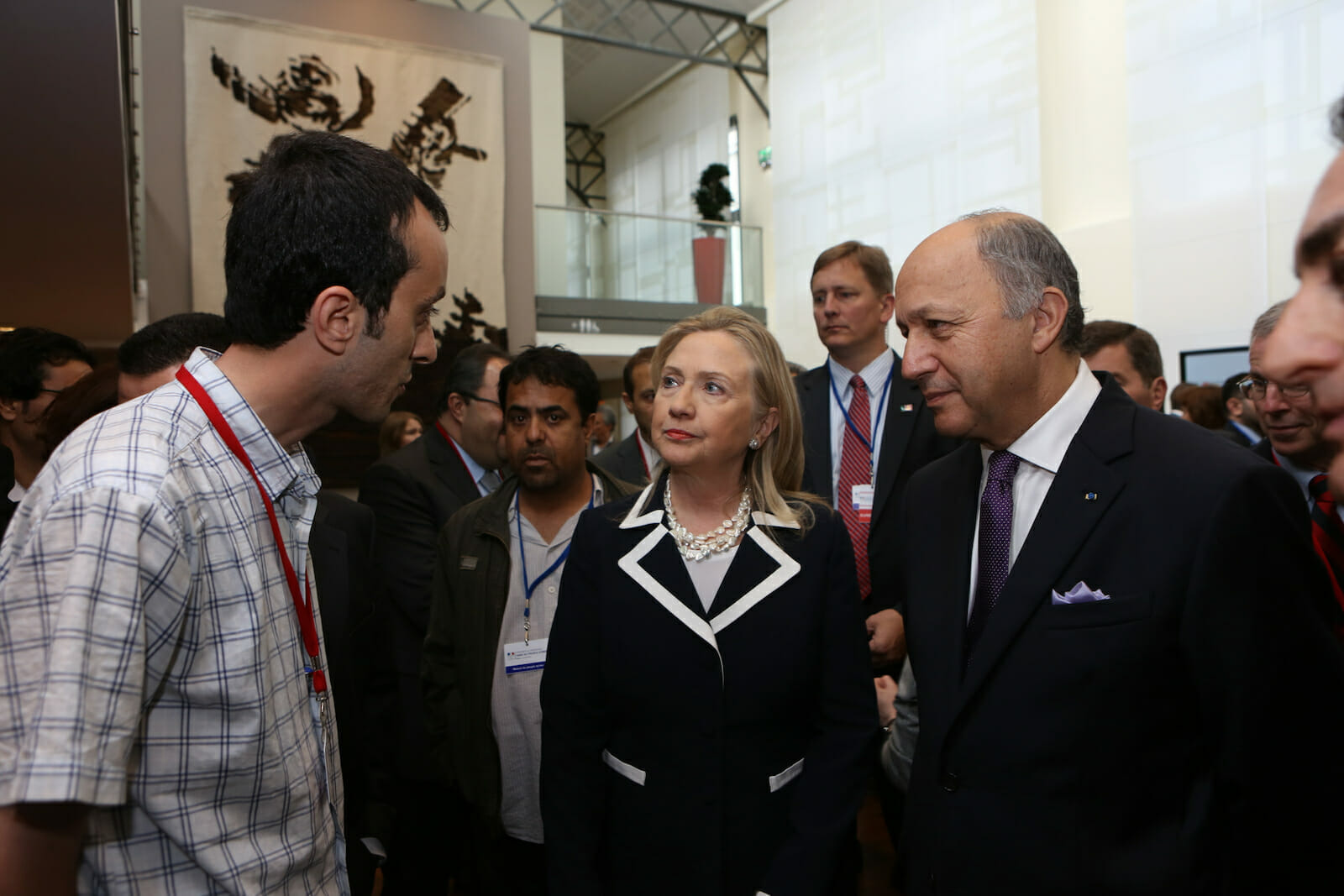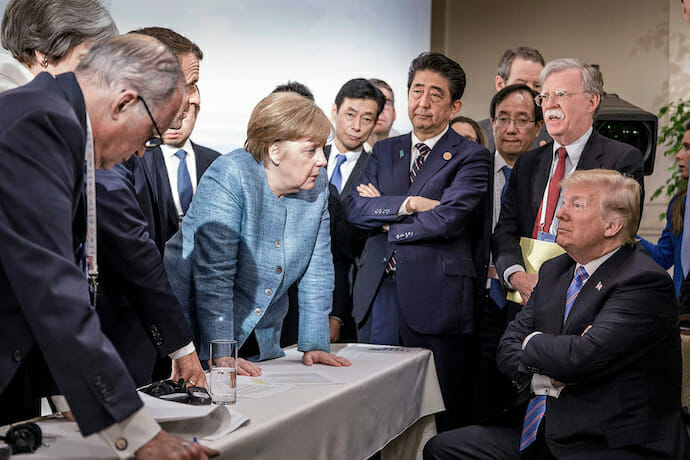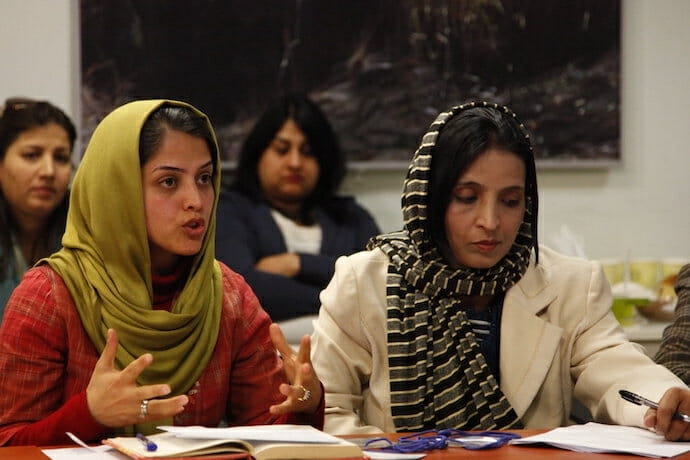
Culture
Girls & Gunmetal: The Power of Women in International Politics and the Military
Women have long been excluded from the field of international relations and its associated institutions – this ranges from politics to the military, to even social spheres. This is extremely unreasonable. Not simply because women make up 49.6% of the world’s population, but because there have been hundreds of women throughout history that bring success to their respective nations. The exclusion of women is the outcome of several factors. Some say that women are too emotional to hold a public office or be a relevant figure in the military. Others argue that women are simply less capable than men to succeed in positions of power – a perception some women hold as a result of the male-dominated political, economic, social, and military spheres. Some scholars have even turned to biology as the be-all and end-all reason as to why women are “less aggressive” – and therefore less competent – than men.
I argue under the lens of feminist international relations that women are just as capable as men to succeed in politics and the military. The barriers that women have faced in the field of IR are outdated and sexist. The inquiries surrounding biological relevance and patriarchal culture should not prevent women from entering IR as a powerful force of positive change.
Feminist international relations
In broad terms, feminist international relations is the field of IR that analyzes the divide between men and women in global affairs. The divide itself is extremely complex and weaves together threads of history, academia, political and gender identity, power, and resistance. Feminist IR has expanded and built on the fields of feminist political and economic theory. This has provided an in-depth examination of the masculinist framing of politics and economics and associated institutions. By doing as such, scholars are better able to analyze and understand the intricate patterns of gender bias and inequality in international affairs.
There are difficulties with feminist international relations that must be addressed. Just as with any other theory of IR – such as realism, liberalism, and constructivism – oversimplification is a clear issue. The underestimation of local values, practices, norms, and social class can distort global political and economic structures. Feminist international relations also faces scrutiny, as IR has been one of the last fields to open up to feminism. It was not until the late 1980s and into the early 1990s that conferences and published literature created enough momentum to truly spark a feminist study of IR. This lack of recognition is likely to also be the effect of the male-dominated academic and political spheres. The absence of women and their lack of power was not deemed an issue by the individuals at the forefront of these fields.
The primary problem with feminist international relations is misunderstanding the true intentions of the field. When whittled down, this misunderstanding often stems from accusations that feminists are implying that women are more peaceful than men or that a world run by women would be less violent and morally superior. World-renowned political scientist Francis Fukuyama even stated in his article “Women and the evolution of world politics” that, “a world run by women would follow different rules.” He then goes on to express how gender segregation in certain parts of the military is not only recommended but truly necessary based on biological factors. However, scholar Ann Tickner – a strong proponent of feminist IR – explains in her article “Why women can’t run the world: International politics according to Francis Fukuyama” that these “peace” oriented stereotypes are damaging to women and peace in general. People often assume that the feminist view of politics sees violence, power, and status as the results of a patriarchal culture. Opponents of the theory instead point to biology to explain men’s tendencies toward aggression.

However, the feminist theory of IR certainly does not exclude biological factors and accounts for patriarchal culture in a tasteful manner. To assume that either factor is the sole cause of global competition is a grave inaccuracy. Even if we were to accept that males have aggressive tendencies – the leap from aggressive men to aggressive states is problematic and unreasonable. Some male academics, Fukuyama included, argue that women are not able to deal with today’s threats that come from violent leaders. However, this is simply untrue and stems from the stereotypes that women are more peaceful and morally restrained. What IR feminists have argued is that we get rid of the idealistic association of women with peace. The bondage of females with a motherly and peaceful nature is impractical and has long served to disempower women and keep them in the “domestic” sphere – which is outside of international affairs and politics. Rather than bend to the untrue assumption that aggressive men and peaceful women are the results of biology, scholars in feminist international relations are striving to better analyze and understand unequal social hierarchies – including gender pyramids, which encourage conflict, inequality, and oppression.
Rather than suggest that traditional international relations theories are gender-neutral, feminist theory has shown that traditional IR is in fact gender-blind. The absence of women in traditional IR theories can be seen both in women’s marginalization from decision-making and in the assumption that women’s everyday lives are not affected by or important to international relations. Feminist international relations takes gender very seriously when analyzing international affairs and politics. We cannot simply expect successful development in international relations if we are not able to transform the gender power dynamics that have impeded this success initially. Women have been and can be, extremely influential figures in international relations – politically, economically, socially, and militarily.
Women in politics
Due to the barriers that females face in international relations, women did not become a prominent fixture in politics for a very long time. The cultures of every state in the world vary greatly, and as a result, so does the time period in which women entered the political playing field. But it is very clear that even now – women are widely underrepresented in government and international affairs. Out of 193 UN member-states, only 22 have female heads of state. Only 14 countries have at least 50% women in the national cabinet, and only 4 have at least 50% women in the national legislature. Since 1946, only 66 countries have had at least one female head of state.
As of September 2020, only 1 country (Cuba) has had at least 50% female representation in elections for national legislature positions – this is likely a result of the perception that women are unable to be capable members of government, they are turned away from running in the initial stages of polling. The political parity score is an aggregate measure of the representation of women in a country’s government. Therefore, a score of 100 indicates that women have at least 50% representation in all levels of government with available data. Only 20 countries have a score of 50 or greater. The closest to a score of 100 is Costa Rica with a score of 74. At the current rate of development, gender equality in the highest positions of political power will not be reached for another 130 years. With an annual increase of just 0.52 percentage points, gender parity in executive positions will not be achieved before 2077.

Despite this lack of female representation, it has been proven that women’s leadership promotes bipartisanship, equality, and stability both in their states and globally as a result of international relations. When women make up a critical portion of a legislature – roughly 25 to 30% – they are more likely than men to challenge established conventions and traditional policy agendas. Women are also more likely than men to cross party lines in order to find common ground and reach a consensus. Female law and policymakers are more likely to advocate for policies that support education and health. In fact, parliaments with a higher proportion of women are more likely to pass and subsequently implement legislation that advances gender equality, including laws on domestic violence, rape, and sexual harassment. One study even found that when women’s parliamentary representation increases by 5%, a country is almost five times less likely to respond to an international crisis with violence.
Outside of the realm of international relations, therefore within the countries themselves, women’s parliamentary representation is associated with a decreased risk of civil war and lower levels of state-perpetrated human rights abuses. To be frank, the election of women into government does not guarantee any of these positive results. Holding political office is only the first step to wielding political power. In many countries, institutional structures and political systems still limit women’s ability to influence policy. Women are not a homogenous group – and as stated earlier – the study of feminist international relations does have difficulties with oversimplification. However, it is fair to state that an increase of female participation in politics would promote these results overall and create a better world not only for women but for men as well.
There have been a plethora of female figures in politics and international relations that have changed the world for the better. Not nearly as many actors as men, yet these women stand as evidence that an increase of women in government would be globally beneficial. It can be argued that women truly began to make waves in IR in the late 1900s, specifically 1960 when Sirimavo Bandaranaike became the first female elected prime minister of Sri Lanka. She served as head of state from 1960-65 and then again from 1970-77. Bandaranaike is known by most for nationalizing many businesses and establishing a state-run economic system. Her daughter, Chandrika Kumaratunga, would serve as Sri Lanka’s prime minister, and from 1994-2005, its first woman president. There had been moments previously in history when women were prominent in politics, but Sirimavo Bandaranaike was undeniably a game-changer.
In 1916, four years before the 19th amendment guaranteed women the right to vote, Jeannette Rankin became the first woman to hold federal office as the representative for Montana in the U.S. Congress. She was a Republican and a strong women’s rights advocate. She voted against U.S. entry into the First World War, effectively destroying her prospects for reelection. However, she spent the next 20 years campaigning for world peace and was once again voted into Congress in 1940. She famously claimed that while she may have been the first woman in Congress, she would certainly not be the last, and she was right. Since 1916, a total of 393 women have served as U.S. representatives, delegates, or senators. Now Kamala Harris serves as the first female, the first South Asian American, and the first Black American vice president in the United States.
Margaret Thatcher quickly rose through the ranks of the British Conservative Party, becoming its leader in 1975 and, four years later, the nation’s first female prime minister and the first woman to lead a major Western country. Thatcher took a hard line against communism – earning her a nickname from the Soviet press, the “Iron Lady” – and set the UK on a rightward path economically, promoting free-market policies and weakening labor unions. Thatcher was a key player in the European Union and displayed her power during the Single European Act (SEA) negotiations. Her 11 years in office made her the longest-serving British prime minister of the 20th century, and subsequently – the most impactful.

In 1980, Vigdís Finnbogadóttir of Iceland became the first woman democratically elected president of a country. She also won three other elections, making her the longest-serving non-hereditary female head of state in history – she was president for 16 years. She ran unopposed in two elections and won more than 96% of the vote in the other. Her political success jumpstarted Iceland’s impressive record of gender equality.
First female president of Liberia (2006-2018) and Nobel Peace Laureate, internationally known as “Africa’s Iron Lady,” Ellen Johnson Sirleaf is a force to be reckoned with. In 2005, Sirleaf beat out a slate of male candidates in Liberia’s first presidential election since the civil war’s end, winning with support from nearly 80% of female voters. Over her 12 years in office, she helped preserve peace, erase the national debt and build up Liberia’s economy. She earned a Nobel Peace Prize in 2011 for her work in the field of women’s rights. However, she also drew criticism for nepotism and claims of corruption.
Angela Merkel became Germany’s first female chancellor, its first East German chancellor, and its youngest chancellor in 2005. During her time in office, she bridged the eurozone debt crisis, the refugee crisis movement, and Britain’s planned exit from the European Union. This left Merkel as the leader of Europe’s most populous and powerful country, and the fourth-largest economy in the world. She won her fourth election in 2017 and announced that it would be her last. She has alluded to wanting another woman to take her place in office. Merkel famously stated that “I might bend but I will never break because it’s in my nature as a strong woman.” The UN has also formed the “United Nations Entity for Gender Equality and the Empowerment of Women,” also known as UN Women. This organization is intended to pursue gender equality in the modern world and eliminate discrimination.
Women in the military
Not only have women in politics influenced their countries and international relations, but women in the military have as well. Though the defense ministry has long been a bastion of male power, a growing number of states have appointed women to this portfolio as defense ministers and ranked members of the armed forces. In areas where women remain excluded from this portfolio, the traditional beliefs about the masculinity of military positions remain. This is often seen in states that are engaged in fatal disputes, governed by military dictators, and large military spenders. Women typically emerge in countries concerned with peacekeeping and in former military states with left-wing governments. This is not to state that peacekeeping is the goal of the woman in charge. In fact, most females take on the position with staunch authority and power to control a male-dominated field. A reduction of violence should not be a tactic associated with only women, as it constrains their policy abilities. Instead, the appointment of females as defense ministers and in positions of military power should represent a bridge in the gender divide.
Women currently do not play a massive role in the military despite their successes in the field. In fact, women play far less of a role in the military than they do in politics. In China, less than 5% of the People’s Liberation Army is women. In India, women make up only 3% of the army. In South Korea, 5.5% of the senior military ranks are held by women. In Russia, women comprise 10% of the armed forces. The highest ratio of women to men emerges in North Korea, where there is selective conscription for women and universal conscription for men. Women serve a maximum of six years and men for 10, so it is likely that women make up roughly 40% of the Korean People’s Army Ground Force. Just as with the political lens of international relations, the military lens lacks females. It is unreasonable to have such few women in the military, considering that more typically desire to join and are simply encouraged not to or are turned away.
In the United States, women have been important to the military from the Revolutionary War to present-day conflicts. During the First World War, about 35,000 women officially served as nurses and support staff. During the Second World War, 140,000 women served in the U.S. Army and the Women’s Army Corps (WAC) performing critical jobs such as military intelligence, cryptography, and parachute rigging. Over 1,000 women flew aircraft for the Women Airforce Service Pilots (WASP). However, it wasn’t until the Second World War that women gained recognition as full-fledged members of the military. From the WAC, WASP, Marine Corps Women’s Reserve, and the Navy’s WAVES (Women Accepted for Volunteer Emergency Service), women proved that this was their war too and that they embodied the “Rosie the Riveter” attitude. President Truman agreed – thus the Women’s Armed Services Integration Act was signed into law on June 12, 1948. With this Act, women could finally claim the same benefits as their male counterparts, and it also allowed women to make a career in the Army or Navy. Today, over 700,000 women have served during the post-9/11 wars, including Operation Enduring Freedom and Operation Iraqi Freedom. Women currently make up 16% of the U.S. military and are a resounding force for freedom and power. There have been several women in the U.S. military who are renowned for their service and tenacity.
In Afghanistan, many of the women that are members of the National Assembly of Afghanistan, also serve as government ministers due to their experience on the ground. There are several female officers in Afghanistan’s National Security Forces, and women account for over 24% of Afghans in the medical profession. This is not to say that women do not still face the risk of a strong cultural, tribal, and familial backlash. But there have been advancements due to the slow recognition of females being pillars of power.
As of May 2020, there are 21 female defense ministers across the 159 countries with militaries. This includes 7 out of the 30 NATO member states. Ursula von der Leyen was Germany’s first female defense minister. She took over the defense ministry back in December 2013, when Germany’s armed forces were in shambles. Military equipment was counted by hand and many records existed only on paper. Von der Leyen made it her mission to reform the apparatus and hired external advisers that assisted in the overseeing of significant projects. An increase in German defense spending was initiated as well. While there were issues regarding leaked information during von der Leyen’s time as defense minister, she was nonetheless plucked from Angela Merkel’s cabinet and elevated to the European Commission presidency in the summer of 2019.
As of modern times, the best defense in the world appears to be adding more women as defense ministers. This revolutionary step is like a symbolic laying down of the gauntlet to one of the most male-dominated sectors on the planet. The three approaches currently being implemented around the world to encourage more women to join the army are the “gender-blind” strategy, the “make it a women’s issue” strategy, and the “adapt the model” strategy. In the first, women are encouraged to become as much like men as possible – or be cast in stereotypically female roles. This strategy is proven to be the least effective. The second approach aims to integrate women by tailoring a limited number of elements to their specific needs. The final, and much rarer, strategy is to question the existing model and change it for everyone. France follows the last strategy and prides itself on having the world’s fourth most feminized military. The rest of the world should look to France as a positive example for change.
***
Women are still severely depreciated and demeaned in international relations – especially in the fields of politics and the military. Women make up nearly 50% of the world’s population and should be represented according to that statistic. Feminist international relations does not claim that women are more peaceful than men, or that they are morally superior. Instead, it simply highlights the research on the gender divide in international affairs and encourages the world to elect more women to positions of power. As evidenced by the variety of women detailed above – females in power are certainly not a bad thing. If anything, bridging the IR divide between men and women encourages healthy bipartisanship and the demise of the patriarchal cultural norms that plague the world. Despite feminist international relations being a fairly new study in the field of foreign affairs, the denomination is promoting positive outcomes for women all around the world.

